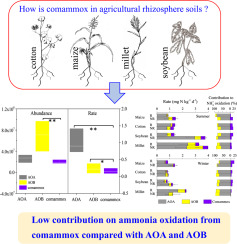当前位置:
X-MOL 学术
›
Sci. Total Environ.
›
论文详情
Our official English website, www.x-mol.net, welcomes your feedback! (Note: you will need to create a separate account there.)
Comammox bacterial abundance, activity, and contribution in agricultural rhizosphere soils.
Science of the Total Environment ( IF 9.8 ) Pub Date : 2020-04-08 , DOI: 10.1016/j.scitotenv.2020.138563 Xiaomin Wang 1 , Shanyun Wang 2 , Yingying Jiang 2 , Jiemin Zhou 2 , Chang Han 2 , Guibing Zhu 1
Science of the Total Environment ( IF 9.8 ) Pub Date : 2020-04-08 , DOI: 10.1016/j.scitotenv.2020.138563 Xiaomin Wang 1 , Shanyun Wang 2 , Yingying Jiang 2 , Jiemin Zhou 2 , Chang Han 2 , Guibing Zhu 1
Affiliation

|
The newly identified complete ammonia oxidation (comammox), which is capable of oxidizing ammonia directly to nitrate, has complemented our knowledge of nitrification in the global nitrogen (N) cycle. However, understanding the contribution and ecological roles of comammox in complex soil environments is still in its infancy. Here, the community structure and function of comammox and the interactions with other ammonia oxidation processes in rhizosphere and non-rhizosphere soils of four different crop fields (maize, cotton, soybean, and millet) were investigated in summer and winter. The only identified comammox species Candidatus Nitrospira nitrificans was widely distributed in all sampled soils. Comammox bacterial abundance was lower than that of ammonia-oxidizing archaea (AOA) and ammonia-oxidizing bacteria (AOB). The measured comammox potential rate ranged from 0.01 ± 0.002 to 0.40 ± 0.02 mg N kg-1 d-1, contributing <19.2 and 22.1% to ammonia oxidation in summer and winter, the remainder being due to AOA and AOB. The potential rate and community composition of comammox bacteria were significantly different on a temporal scale, while crop species and soil types (rhizosphere and non-rhizosphere) showed no obvious influences. In terms of oxidation rates, AOA (1.2 ± 0.7 mg N kg-1 d-1) dominated the ammonia oxidation in agricultural soils over AOB (0.31 ± 0.1 mg N kg-1 d-1) and comammox (0.2 ± 0.1 mg N kg-1 d-1). Both anammox bacterial abundance and activity were below the detection limits, indicating a negligible contribution of anammox in agricultural rhizosphere soils. The identification of comammox bacterial abundance and activity in situ enriches our knowledge of nitrification in agricultural systems.
中文翻译:

农业根际土壤中的Comammox细菌的丰度,活性和贡献。
新近确定的完全氨氧化(comammox)能够将氨直接氧化成硝酸盐,补充了我们在全球氮(N)循环中的硝化知识。但是,了解comammox在复杂土壤环境中的作用和生态作用仍处于起步阶段。在这里,研究了夏季和冬季四种作物田(玉米,棉花,大豆和小米)的根际和非根际土壤中comammox的群落结构和功能以及与其他氨氧化过程的相互作用。唯一确定的昏迷物种念珠菌Nitrospiranitroificans广泛分布在所有采样土壤中。Comammox细菌的丰度低于氨氧化古细菌(AOA)和氨氧化细菌(AOB)。测得的昏迷电位率为0.01±0.002至0.40±0.02 mg N kg-1 d-1,在夏季和冬季对氨氧化的贡献分别小于<19.2和22.1%,这归因于AOA和AOB。comammox细菌的潜在发生率和群落组成在时间尺度上有显着差异,而作物种类和土壤类型(根际和非根际)则没有明显的影响。就氧化速率而言,AOA(1.2±0.7 mg N kg-1 d-1)在农业土壤中的氨氧化作用高于AOB(0.31±0.1 mg N kg-1 d-1)和昏迷(0.2±0.1 mg N) kg-1 d-1)。厌氧菌的细菌丰度和活性均低于检测极限,表明厌氧菌在农业根际土壤中的贡献可忽略不计。
更新日期:2020-04-08
中文翻译:

农业根际土壤中的Comammox细菌的丰度,活性和贡献。
新近确定的完全氨氧化(comammox)能够将氨直接氧化成硝酸盐,补充了我们在全球氮(N)循环中的硝化知识。但是,了解comammox在复杂土壤环境中的作用和生态作用仍处于起步阶段。在这里,研究了夏季和冬季四种作物田(玉米,棉花,大豆和小米)的根际和非根际土壤中comammox的群落结构和功能以及与其他氨氧化过程的相互作用。唯一确定的昏迷物种念珠菌Nitrospiranitroificans广泛分布在所有采样土壤中。Comammox细菌的丰度低于氨氧化古细菌(AOA)和氨氧化细菌(AOB)。测得的昏迷电位率为0.01±0.002至0.40±0.02 mg N kg-1 d-1,在夏季和冬季对氨氧化的贡献分别小于<19.2和22.1%,这归因于AOA和AOB。comammox细菌的潜在发生率和群落组成在时间尺度上有显着差异,而作物种类和土壤类型(根际和非根际)则没有明显的影响。就氧化速率而言,AOA(1.2±0.7 mg N kg-1 d-1)在农业土壤中的氨氧化作用高于AOB(0.31±0.1 mg N kg-1 d-1)和昏迷(0.2±0.1 mg N) kg-1 d-1)。厌氧菌的细菌丰度和活性均低于检测极限,表明厌氧菌在农业根际土壤中的贡献可忽略不计。

























 京公网安备 11010802027423号
京公网安备 11010802027423号